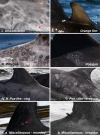Prevalence of epidermal conditions in California coastal bottlenose dolphins (Tursiops truncatus) in Monterey Bay
- PMID: 21089999
- PMCID: PMC3357673
- DOI: 10.1007/s13280-010-0066-8
Prevalence of epidermal conditions in California coastal bottlenose dolphins (Tursiops truncatus) in Monterey Bay
Abstract
The prevalence of epidermal conditions in a small population of coastal bottlenose dolphins (Tursiops truncatus) in Monterey Bay was evaluated between 2006 and 2008. Five different skin condition categories were considered, including Pox-Like Lesions, Discoloration, Orange Film, Polygon Lesions, and Miscellaneous Markings. Of 147 adults and 42 calves photographically examined, at least 90 and 71%, respectively, were affected by at least one or multiple conditions. Pox-Like Lesions were the most prevalent, affecting 80% of the population, including adults and calves. This condition warrants the most urgent investigation being possibly indicative of the widespread presence of poxvirus or a similar pathogen in the population. In view of the high number of individuals affected, standard monitoring of the health status of Monterey Bay bottlenose dolphins is considered imperative. Discoloration was strongly associated with Pox-Like lesions. Orange Films were likely an epifaunal infestation caused by diatoms, which have been documented in other cetacean species. Polygon Lesions, a newly described category, could be the result of infestation by barnacles of the genus Cryptolepas. Miscellaneous Markings were variable in appearance and may not have the same causative factor. Although none of the proposed etiologies can be confirmed without appropriate clinical tests, recognizing common visible characteristics of the conditions could aid in preliminary comparisons across populations and individuals.
Figures

Similar articles
-
Skin lesions on common bottlenose dolphins (Tursiops truncatus) from three sites in the Northwest Atlantic, USA.PLoS One. 2012;7(3):e33081. doi: 10.1371/journal.pone.0033081. Epub 2012 Mar 12. PLoS One. 2012. PMID: 22427955 Free PMC article.
-
Epidemiological investigation of tattoo-like skin lesions among bottlenose dolphins in Shark Bay, Australia.Sci Total Environ. 2018 Jul 15;630:774-780. doi: 10.1016/j.scitotenv.2018.02.202. Epub 2018 Feb 27. Sci Total Environ. 2018. PMID: 29499535
-
Skin lesions and physical deformities of coastal and offshore common bottlenose dolphins (Tursiops truncatus) in Santa Monica Bay and adjacent areas, California.Ambio. 2009 Mar;38(2):66-71. doi: 10.1579/0044-7447-38.2.66. Ambio. 2009. PMID: 19431934
-
The Gulf of Ambracia's Common Bottlenose Dolphins, Tursiops truncatus: A Highly Dense and yet Threatened Population.Adv Mar Biol. 2016;75:259-296. doi: 10.1016/bs.amb.2016.07.002. Epub 2016 Aug 25. Adv Mar Biol. 2016. PMID: 27770987 Review.
-
Health and Environmental Risk Assessment Project for bottlenose dolphins Tursiops truncatus from the southeastern USA. II. Environmental aspects.Dis Aquat Organ. 2017 Jul 24;125(2):155-166. doi: 10.3354/dao03143. Dis Aquat Organ. 2017. PMID: 28737160 Review.
Cited by
-
Epidemiology of skin changes in endangered Southern Resident killer whales (Orcinus orca).PLoS One. 2023 Jun 28;18(6):e0286551. doi: 10.1371/journal.pone.0286551. eCollection 2023. PLoS One. 2023. PMID: 37379317 Free PMC article.
-
Skin Marks in Critically Endangered Taiwanese Humpback Dolphins (Sousa chinensis taiwanensis).Animals (Basel). 2023 Feb 9;13(4):608. doi: 10.3390/ani13040608. Animals (Basel). 2023. PMID: 36830394 Free PMC article.
-
Skin lesions on common bottlenose dolphins (Tursiops truncatus) from three sites in the Northwest Atlantic, USA.PLoS One. 2012;7(3):e33081. doi: 10.1371/journal.pone.0033081. Epub 2012 Mar 12. PLoS One. 2012. PMID: 22427955 Free PMC article.
-
Epidermal Lesions and Injuries of Coastal Dolphins as Indicators of Ecological Health.Ecohealth. 2019 Sep;16(3):576-582. doi: 10.1007/s10393-019-01428-0. Epub 2019 Jul 22. Ecohealth. 2019. PMID: 31328242
References
-
- Addison RF, Brodie PF. Transfer of organochlorine residues from blubber through the circulatory system in milk in the lactating grey seal, Halichoerus grypus. Canadian Journal of Fisheries and Aquatic Sciences. 1987;44:782–786. doi: 10.1139/f87-095. - DOI
Publication types
MeSH terms
LinkOut - more resources
Full Text Sources
Medical

